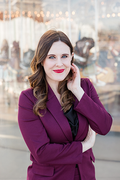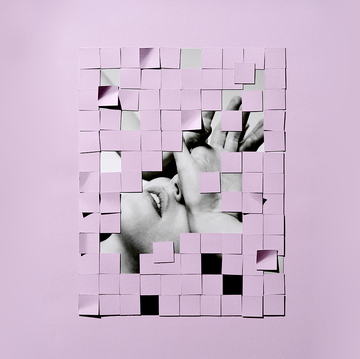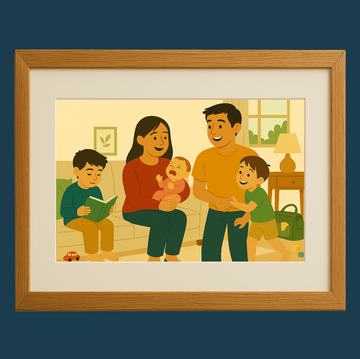There’s a story my husband and I always love to tell new friends. Back when we first started dating — those long, luxurious hours filled with endless conversation — he casually mentioned that in Denmark, where he’s from, it’s totally normal for babies to nap outside. In all kinds of weather. Even when it’s freezing.
He explained how parents will tuck their babies into snuggly bassinets, leave them outside a café and go inside for a coffee. Today, they’ll use a simple audio monitor. In the ’80s, his mother didn’t use a monitor at all. He claimed it was good for their health and even made them better sleepers.
As someone who spent years traveling the world as a journalist, I thought I’d heard it all — but this absolutely floored me. My anxious, type-A American brain couldn’t comprehend it.
“What if the baby got kidnapped?” I asked, horrified.
He blinked, shrugged, and said, “Who would want to kidnap a baby? They’re a lot of work.”
It’s probably funnier to us than to anyone else, but that conversation perfectly captures what it’s like raising multicultural children. It all seems foreign … until it doesn’t. We’re married now with two daughters — both of whom, believe it or not, have taken most of their naps outside. Not quite curbside in Copenhagen, but on our screened-in porch at our home in western North Carolina, bundled up and with a monitor nearby. And he was right: they slept so well. Especially in the cold.
Raising multicultural kids is equal parts joy and chaos, with a healthy dose of privilege. My husband moved here for college over a decade ago and will soon become a citizen. When we met — right before he received his green card from work — we talked often about how we wanted our future children to inherit the best of both of our cultures, values and worlds. While we’re currently rooted in North Carolina, our long-term plan is to move to Denmark once the girls reach school age, giving me the chance to be the immigrant this time around.
So far, the journey has been full of beauty — and challenges. Navigating two very different countries, traditions and sets of parenting opinions isn’t always seamless. But the in-between space is where our family lives. And that space? It’s starting to feel like home.
English, Danish or Josefine-ish?
On the advice of our pediatrician, we decided early on to raise our first-born daughter, Josefine, in a bilingual home: my husband would speak exclusively Danish to her and I would speak English. He reads her Danish books, sings Danish songs and keeps the language alive through daily conversation and ritual. We’ve asked his Danish family and friends to do the same, whether it’s over FaceTime or during our annual trips to Denmark. I don’t speak Danish — quite yet! — but I’m learning as she does.
Our very talkative now 3-year-old today speaks at lightning speed, switching between English and Danish words, and we just do our best to keep up. And to translate: We often have to decipher if she’s speaking English, Danish or Josefine-ish, her own made-up language that’s a mix between both of her parent’s native tongues.
Since English is the language she hears most — at daycare, with friends and throughout our daily life here — that’s what she speaks most often. But she understands everything her dad says to her in Danish, even if she answers in English. Parenting in a language you don’t fully understand adds a whole other layer to the experience — I often feel like I’m witnessing a relationship I can’t entirely access.
We’re hopeful that as she grows, and especially as we eventually spend more time in Denmark, both languages will come more naturally. It’s a slow, imperfect process, but we know that early exposure to multiple languages can support brain development and deepen her connection to both sides of her family.
When picking Josefine’s name and her sister’s Maya’s name, it was important to us for them to make sense and be easy to pronounce in each language. My husband is Rasmus, which is challenging for Americans to pronounce, and mine is Lindsay, which isn’t a name at all in Denmark. We went with the Danish spelling for Josefine’s name, and picked the English spelling for Maya’s, since we thought the Danish spelling — Maja — would be confusing outside of Nordic countries.
Trying to learn Danish alongside my children has had its ups and downs. While I still stumble when trying to respond, I can easily follow along when my husband asks Josefine to grab her shoes, choose a snack, or — for the love of god — please go to sleep. It’s a skill that’s already proving useful as our girls grow. Not only do I have hopes of becoming bilingual myself, but there's an added bonus: they won’t be able to talk behind my back to their dad when they’re teenagers.
Different countries, different recommendations
When you bring your brand-new baby home from the hospital in the United States, the nurses tell you to look for one diaper on day one, two diapers on day two, three on day three — and so on. And if your baby isn’t meeting this golden rule, you call the doctor ASAP. This all seems straightforward enough, but on day four, when Josefine didn’t have the four diapers — we panicked. Our doctor’s office was closed for the weekend, so we had to call the nurse hotline who told us she wasn't eating enough and the panic intensified. I pumped around the clock, gave her breastmilk through a syringe and counted down the hours until 8 a.m. on Monday arrived for the first available ‘emergency’ appointment.
In the meantime, my husband thought to look up the Danish recommendations on diapers and newborns, and found it was more lenient and offered more of a range, versus a hard-fast rule. This gave us peace of mind and it inspired our "parenting philosophy" ever since. We look at the United States recommendations and the Danish authority, and we find what works for us somewhere in the middle.
However, we are careful not to talk about it to our friends or family because, well, everyone will have an opinion since in many cases, they are vastly different. For example, in the U.S., sleep recommendations are more cautious, following strict AAP (American Academy of Pediatrics) guidelines around supervised sleep and controlled environments — no bumpers, no blankets, no anything. In Denmark, as you know, babies sleep outside bundled up, co-sleeping is common and baby monitors are not always used.
In Denmark, breastfeeding is strongly encouraged — and funded. Lactation support is available and free for those who need it. Because parental leave is much longer (usually up to a year), women have more time to navigate breastfeeding challenges without having to worry about ‘building up a freezer stash’ for returning to work. Solids like rye bread and liver pâté are often introduced between four and six months. In the U.S., breastfeeding is strongly promoted by health institutions, yet there is no federal support for new mothers. The conversations around formula feeding are changing but still carry a stigma in mom circles. Solids typically start around six months, with an emphasis on purées or baby-led weaning, depending on the trendy parenting philosophy of the moment.
As Josefine has grown into toddlerhood, we’ve naturally started leaning into what my husband jokingly calls “a healthy amount of Danish gaslighting.” In Denmark, kids are raised to be independent from the start and are viewed as valued members of society — not just tiny people to manage and encourage to "be quiet" and "sit still." Crying isn’t treated as a crisis: it’s seen as a normal part of baby and toddlerhood, which means there’s less pressure to constantly “fix” it. Parents are generally more relaxed about letting children self-soothe.
You can see this cultural difference play out on playgrounds in Copenhagen, where kids of all ages roam freely and confidently, while parents watch from nearby benches — not hovering, just present. It’s a stark contrast to the helicopter-style supervision you often see in the U.S., and honestly, it’s kind of liberating.
We’ve learned there’s no perfect recipe that blends our cultures — and we don’t always see eye-to-eye. Our biggest point of tension is around safety and independence as our toddler plays. In his Danish upbringing, kids are encouraged to roam more freely, take risks and maybe even get a little hurt. It’s seen as a natural part of learning.
I, on the other hand, am more cautious. My instinct is to hover, redirect, anticipate every fall. Navigating that difference has taken some trial and error … and a lot of compromise. He’s comfortable letting her play alone in our playroom; I asked to install a camera so I can peek in when I need to. If they head to the “big playground” in town — the one with the steep slides and climbing nets that make me a little nervous — I stay home and trust that he’s got it covered. (Which, of course, he does.) These kinds of trade-offs have become our way of honoring both perspectives while building something that works for our family.
Blending of traditions and mourning of "home"
One of the things I love most about Danish culture is its deep-rooted traditions. Holidays, birthdays any kind of celebration — they’re all marked with rituals that feel rich, universal and proudly shared. There’s a collective sense of identity around these moments that’s quite different from what I experienced growing up in the United States. Of course, Denmark is much smaller — its entire population is less than that of New York City — so it’s easier to cultivate a national culture with shared traditions.
In the U.S., traditions are hyperlocal. They vary by zip code, by region, by family history. I grew up in the South, then spent a decade in New York City, then traveled the world for two years, then Boston, before returning home to raise my kids. My husband, on the other hand, had 30 first cousins — and only two of them are currently living outside of Denmark. That kind of closeness is common in Denmark, where many families live just a few blocks from each other. In the States, children grow up and move away. It’s harder to hold onto shared rituals when your village is scattered across time zones.
Now, as a blended family, we’re doing our best to preserve and combine both cultures by not choosing either/or, but embracing and. We light the advent candle and open presents on Christmas Day. Santa, according to Danish tradition, lives in Greenland… and the North Pole exists in Christmas movies, too. (My kids are too young to question how exactly Santa splits his time between the two.) We serve English and Danish dishes at Christmas and Easter. We sing “Happy Birthday” in two languages, and we always top our cake with Danish flags. (And on that topic: Danes are crazy about their flags! It’s part of decorating for Christmas, for birthdays, for nearly any gathering or celebration.)
Still, with all the toggling between two cultures, it sometimes feels hard to know what version of home we belong to. Of course, wherever we are with our daughters, that’s home — but one of us is always missing something. My husband misses his family, the pace and comforts of Denmark. When we relocate, I’ll miss mine, along with the convenience and familiarity of American life. There’s a constant tug-of-war between nostalgia and possibility, identity and tradition.
I wonder sometimes how this will shape our daughters as they grow up with dual passports and multiple answers to the question, “Where are you from?” Will they feel an identity crisis? Will they feel stretched between two worlds — or lucky to belong to both? My hope is, like us, they’ll eventually find peace in the in-between.
In Danish, the word for mother is mor — pronounced like more. And that’s exactly how I’ve come to think about this experience of mothering multicultural children: more love, more complexity, more flexibility, more chaos, more joy, more choice. More of everything. And I hope, most of all, that they grow up knowing they got more of the best we could give.

Lindsay Tigar is a national freelance journalist and the co-founder of Mila & Jo Media, media and coaching company providing mother-first, expert-backed and community-centered content and resources. Her work has appeared in USA Today, National Geographic, Vogue, CNN, Time, Real Simple, and countless other publications. A full collection fo her writing can be found at LindsayTigar.com.

















